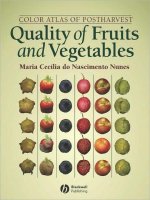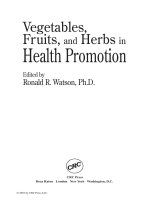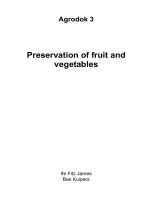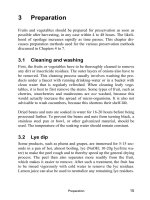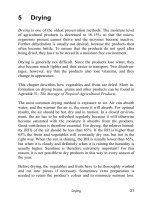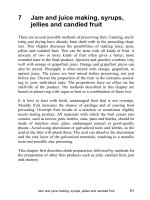Fruits and vegetables
Bạn đang xem bản rút gọn của tài liệu. Xem và tải ngay bản đầy đủ của tài liệu tại đây (1.21 MB, 19 trang )
FRUITS
Nutrition
Fruits are 75 – 95% water
Simple Carbohydrate
Low in fat, sodium and protein
Excellent source of fiber
(especially the skins!)
Vitamins/Minerals Fruits Provide:
Vitamin C (Citrus, melons, strawberries)
Vitamin A (Deep yellow and green fruits)
Potassium (Bananas, raisins, figs)
Nutrition,
Continued
Choose whole or cut up fruits more
often than fruit juice.
Air, Heat and Water Can Destroy
Nutrients in both Fruits and
Vegetables.
Always wash fruits and vegetables to
remove pesticides that might remain
on the skin.
Fresh, Canned or Frozen
Choose your fruits according to:
Fruits that are picked ripe are:
How you will be using them
Price
Season
Oranges
Apples
Grapefruit
Fruits that are picked green, and then ripen:
Pears
Peaches
Bananas
Cantaloupe
Watermelon
Guidelines for Selecting Fruits
Firm
Free From Decay
Crisp
Smooth
Dense
Free From Bruises
Good Color
Good Smell
In Season (Will Be Cheaper)
Fresh Fruits
Seasonal
A fruit that grows during a certain time of
the year.
It is better to buy fruits in season
because they:
Taste better
Cost less
Plentiful
Better quality
Purchasing and Storing Fruits
Storing Fruits In:
Cold (Refrigerator)
Room Temperature
Give Them Space
Storage of Fruits
How long?
1 week
How?
In refrigerator
Fruits spoil faster at room temperature
Bananas should never be stored in fridge
Ripening
Ripening happens when starches found in
the fruit break down into sugar
(Bananas in the fridge)
This leads to deterioration or spoilage:
Color
Lightens
Texture Softens
Decreases in Acidity
Increases in Sweetness
Browning
Browning occurs when the
cut surfaces of food reacts
with oxygen.
This is called OXIDATION.
To prevent this, cover cut
fruits with a liquid
containing Ascorbic Acid
(Vitamin C).
Classes of Fruits
Pomes
Drupes
Oranges, grapefruit, tangerines, lemons, limes
Melons
All berries, strawberries, cranberries, grapes
Citrus Fruits
Peaches, nectarines, apricot, cherry, plums
Berries
Apples, pears, kiwi
Cantaloupe, honeydew, watermelon
Tropical fruits
Banana, pineapple, avocado, dates, figs
VEGETABLES
Rememeber…
Destroy Nutrients
Vegetables
• The term vegetable refers to any
herbaceous plant that can be partially
or wholly eaten
• The plant has no woody tissue
• Vegetables contain more starch
and less sugar than fruits
Nutrition
• Vegetables provide the following
Vitamins and Minerals:
Water Soluble
VITAMINS
Fat Soluble
VITAMINS
Vitamin C
Vitamin A
Vitamin B (Folic Acid)
Vitamin D
Macro Minerals
Potassium
Calcium
Magnesium
Nutrition, continued…
• Vegetables contain NO cholesterol
• They are low in calories, fat and
sodium (They are “Nutrient Dense”)
• Eat more red, orange and dark green
vegetables from the Vegetable
Group.
Best Cooking Methods for
Preserving Nutrients
• The two BEST methods are:
– Microwaving
– Steaming
• You can also:
– Bake
– Stir-Fry
– Simmer
– Sauté
Five Ways to Preserve
Nutrients When Cooking
Fruits and Vegetables
• Cook in larger pieces
• Use small amounts of water
• Cook only until “fork” tender
• Cook quickly
• Save the water used to cook in
for soups and gravies (most
nutrients dissolve into the
water)
10) Vegetables are divided into groups
according to the part of the plant they come
from:
Classification
Vegetables in that Group
A) Fruit
Tomato, cucumber, squash, peppers
B) Flowers
Broccoli, cauliflower
C) Stems
Asparagus, celery
D) Leaves
Cabbage, spinach, brussel sprouts, lettuce
E) Roots
Radishes, beets, carrots, turnips
F) Seeds
Beans, corn, peas
G) Tubers
Potatoes
H) Bulbs
Onion, garlic, leek, green onion



